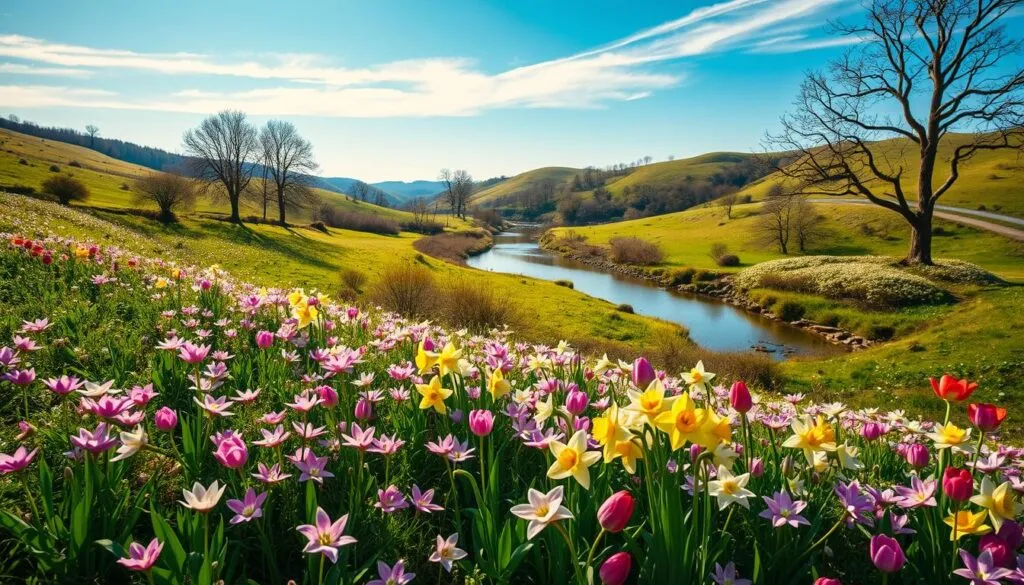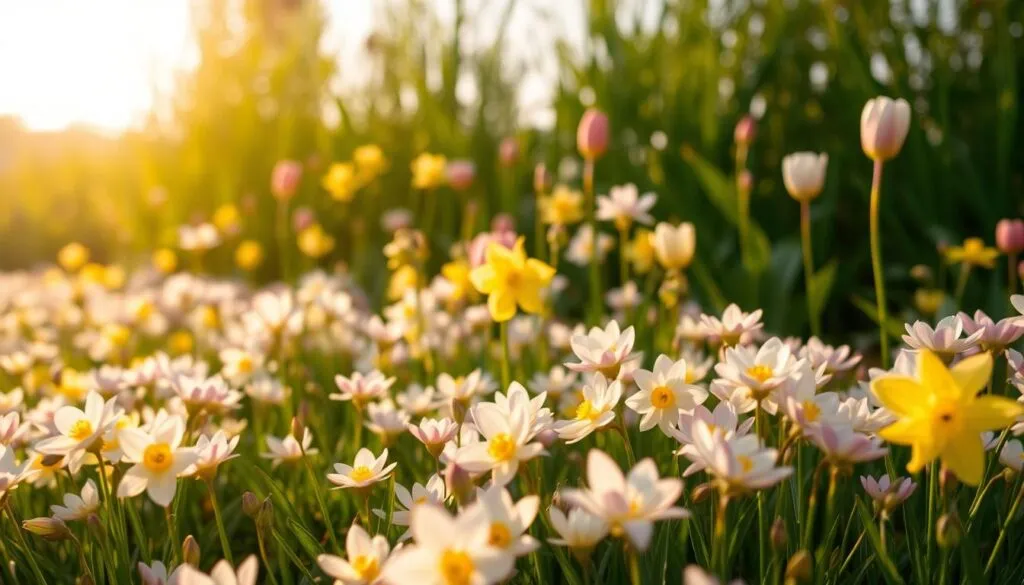Discover the Beauty of March Blooming Flowers
Table of Contents

Winter’s chill fades, and your garden comes alive. March brings flowers that paint the world with color and hope. These blooms show nature’s strength and the beauty of new beginnings.
In Southern areas, gardeners see a stunning change. March starts a colorful show, turning gardens into vibrant art. Each flower tells a tale of survival and beauty.
Your garden is a canvas in March. From small crocus to tall magnolias, these flowers show nature’s rebirth. Knowing about these Blooming Flowers helps you create a beautiful garden that celebrates spring.
Key Takeaways
- March signals the start of spring flowering season
- Southern regions experience earlier and more vibrant blooms
- Diverse flowers bring color and life to gardens
- Early spring blossoms represent nature’s renewal
- Understanding bloom patterns helps garden planning
Understanding Early Spring Flowering Season
As winter fades, the vernal flora starts its magical awakening. Your garden turns into a colorful canvas. Each plant responds to nature’s signals. This dance helps gardeners create stunning displays.

Different factors affect when flowers bloom. Climate is key in timing and success of your garden’s display.
Factors Affecting March Blooms
Several elements influence early spring plants:
- Daylight hours
- Soil temperature
- Precipitation levels
- Microclimate conditions
Climate Zones and Blooming Patterns
Your hardiness zone greatly affects which flowers thrive. Gardeners in warmer regions see blooms sooner. Those in cooler areas experience a delayed spring.
Temperature Impact on Early Bloomers
Temperature changes trigger vernal flora to emerge from dormancy. Warm days encourage plants to grow, starting the blooming season.
Each degree of temperature change can significantly influence when and how your garden springs to life.
Popular March Blooming Flowers in Your Garden

As winter fades, your garden comes alive with vibrant colors. March brings a variety of flowers that make your outdoor space lively again.
Here are some stunning early spring flowers to brighten up your garden:
- Chionodoxa (Glory-of-the-Snow): A quick-spreading bulbous perennial that creates beautiful blue carpets
- Crocus: Charming cup-like flowers in purple, white, and yellow that grow 4-6 inches tall
- Siberian Squill: Delicate blue flowers that reach 4-8 inches in height
- Hellebores: Stunning flowers in white, pink, purple, and green that bloom for 8-10 weeks
Here’s a quick guide to help you plan your garden:
| Flower | Height | Color Range | Bloom Duration |
|---|---|---|---|
| Chionodoxa | 4-6 inches | Blue, White | 2-3 weeks |
| Crocus | 4-6 inches | Purple, White, Yellow | 2-4 weeks |
| Siberian Squill | 4-8 inches | Blue | 3-4 weeks |
| Hellebores | 12-15 inches | White, Pink, Purple, Green | 8-10 weeks |
When picking flowers for March, think about your local weather and soil. These early bloomers are not just pretty. They also help pollinators, making your garden a vital part of nature’s cycle.
Early Spring Bulbs for March Color
March brings a burst of color to gardens as spring blossoms start to bloom. Early spring bulbs are the first to paint the garden with vibrant hues. They grow through the cool soil, welcoming warmer days.
Choosing the right early spring bulbs can make your garden pop. Knowing each plant’s needs ensures a beautiful March garden.
Crocus and Snowdrops: First Bloomers
Crocus and snowdrops are the first signs of spring. They love soil with a pH of 6.0-7.0 and can handle full sun or partial shade. These tiny flowers grow 3-6 inches tall, adding a touch of elegance to the ground.
- Crocus colors range from purple and white to yellow
- Giant Snowdrops bloom in neutral soil conditions
- Both tolerate cool temperatures and early spring conditions
Daffodils and Tulip Varieties
Daffodils dazzle with their bright colors, from yellow to gold. They prefer slightly acidic soil and full sun. Tulips add to the beauty, making your garden a colorful mix.
- Daffodils bloom in various color combinations
- Tulips require neutral soil with pH 6.5-7.5
- Both flowers thrive in full sunlight
Grape Hyacinth and Dwarf Iris
Grape hyacinths and dwarf iris bring charm to your garden in March. Dwarf iris grow 5-6 inches tall, adding a splash of color. These plants do well in different light, from full sun to partial shade.
- Grape hyacinths tolerate acid to neutral soil
- Dwarf iris reach heights of 5-6 inches
- Both provide compact, colorful ground coverage
Planting these early spring bulbs will make your garden a vibrant celebration of spring.
Shade-Loving March Flowers
Not all gardens get lots of sunlight. But, you can still see a beautiful floral awakening in shaded areas. March is a great time for plants to make dark spots in your garden bright and colorful.
Flowers that love shade are very diverse. They grow well in partial to full shade. This makes your garden look amazing during the season when plants start to grow.
- Hellebores (Lenten roses) produce spectacular flowers in white, pink, and purple
- Primroses bring cheerful colors to woodland garden settings
- Lungwort adds visual interest with speckled leaves and delicate blooms
Some top plants for March gardens that don’t need much sunlight include:
| Plant | Shade Tolerance | Bloom Colors |
|---|---|---|
| Hellebores | Full to Partial Shade | White, Pink, Purple |
| Primrose | Partial Shade | Yellow, Pink, Purple |
| Brunnera | Full Shade | Blue, White |
When you plan your shade garden, pick plants that do well in less light. Look for ones with unique leaves and pretty flowers. This will make your garden lively and interesting.
Flowering Trees and Shrubs in March
March is a time of renewal in nature. Flowering trees and shrubs turn gardens into colorful scenes. These plants are the stars of the blooming season, showing off the beauty of spring.
Make your garden come alive with early spring flowers. Each type has its own look and growth style. They can make your outdoor space more beautiful.
Magnificent Magnolia and Forsythia
Southern magnolia trees can grow up to 80 feet tall. They thrive in USDA Hardiness Zones 7-9. Its large, elegant blooms create a spectacular spring showcase. Forsythia trees grow up to 10 feet tall in Zones 5-8. They bloom with bright yellow flowers, marking the end of winter.
Dogwood and Cherry Blossoms
Dogwood trees grow up to 30 feet tall in Zones 5-9. They bloom with delicate white or pink flowers. Flowering cherry trees also reach 30 feet tall and bloom in Zones 5-9. They add ethereal beauty to landscapes in spring.
Carolina Jessamine: A Southern Treasure
Carolina Jessamine is South Carolina’s state flower. It blooms from late February to May. This native plant adds yellow flowers to your garden, attracting pollinators and adding color early in the season.
- Flowering trees add vertical interest to gardens
- Early spring blooms support local wildlife
- Choose plants compatible with your specific climate zone
“In March, trees awaken from winter’s slumber, painting landscapes with vibrant colors and renewed life.” – Garden Design Expert
Ground Cover Plants for March Gardens
Spring brings vibrant ground cover plants to your garden. These low-growing perennials turn your garden floor into a colorful carpet. They add texture and interest to your landscape during the blooming season.
Ground covers are great for gardeners looking to improve their outdoor spaces. They grow between 1 to 6 inches tall. This creates dense mats that block weeds and prevent soil erosion.
- Creeping Phlox: Forms colorful mats up to 6 inches high and 3 feet wide
- Ajuga reptans: Creates fast-spreading carpets about 6 inches tall
- Sedum: Thrives in Zones 3-10 with multiple color variations
- Vinca minor: Spreads 1-2 feet with delicate blue flowers
Choose ground covers based on your garden’s conditions. Different plants do well in different zones and light. Bearberry is hardy to Zone 2, while Hens-and-chicks prefer Zones 3-8.
| Ground Cover | Height | Spread | Hardiness Zones |
|---|---|---|---|
| Creeping Phlox | 6 inches | 3 feet | 3-9 |
| Creeping Thyme | 2 inches | 12 inches | 4-9 |
| Sedum | 3-6 inches | 18 inches | 3-10 |
With the right ground covers, your march garden can quickly change. Most take about 3 years to fully cover your garden. This creates a lush, green carpet that makes your landscape more beautiful.
Native Wildflowers That Bloom in March
March brings a magical transformation to woodland landscapes with native wildflowers. These delicate vernal flora emerge as nature’s first artists. They paint forest floors with subtle colors and intricate designs.
Your journey into native wildflowers reveals fascinating species that thrive in woodland environments. These plants are more than just beautiful. They’re critical components of local ecosystems during the floral awakening.
Bloodroot: A Woodland Treasure
Bloodroot (Sanguinaria canadensis) is one of the most captivating early spring wildflowers. These delicate flowers feature:
- Pristine white petals
- Bloom width of 2 inches
- 8 to 12 petals per flower
- Emerging from deeply lobed leaves
Hepatica and Spring Beauty
Other remarkable native wildflowers include hepatica and spring beauty. These diminutive plants bring understated elegance to woodland settings. They provide crucial early-season nectar for pollinators.
| Wildflower | Bloom Characteristics | Habitat Preference |
|---|---|---|
| Bloodroot | White, 2-inch diameter | Woodland shade |
| Hepatica | Purple, pink, white flowers | Forest floor |
| Spring Beauty | Delicate pink-white blossoms | Moist woodland areas |
Natural Habitat Benefits
Native wildflowers play a crucial role in supporting local wildlife. They provide early-season food for pollinators, stabilize soil, and create complex ecological networks. These networks sustain biodiversity.
By understanding and appreciating these native wildflowers, you contribute to preserving delicate woodland ecosystems. This is during their most vulnerable and beautiful season.
Creating a March Blooming Garden Design
Creating a garden that shows off the first signs of spring needs careful planning. Your March garden can turn your outdoor area into a lively mix of colors and life.
Begin by thinking about the layered look of your plants. Pick ones that bloom at different heights to add depth and interest. Your garden should have:
- Ground-level bulbs like crocuses
- Mid-height perennials such as daffodils
- Taller shrubs and trees like forsythia
Choosing the right colors is key. Pick colors that go well together to create harmony. For example, purple crocuses look great with yellow daffodils.
“A well-designed garden is a symphony of colors, textures, and heights.” – Garden Design Expert
Think about your local climate when picking plants. Some plants do better in certain areas. Ask local garden experts for advice on the best plants for your region.
Make sure to have focal points in your garden. Use things like garden structures, rocks, or special plants to catch the eye and add interest.
- Use magnolia trees as dramatic centerpieces
- Plant clusters of snowdrops near walkways
- Incorporate early-blooming azaleas as accent plants
By mixing plants with different bloom times, you’ll make a garden that celebrates spring’s arrival.
Caring for March Blooming Flowers
As nature awakens, your March flowers need extra care for a stunning display. The right care during this time can greatly improve your garden’s health and look.
Protecting your early spring flowers is key. Late frosts can harm them, so cover sensitive plants when it gets cold. Use lightweight garden fabric or old bed sheets to keep them safe.
- Water early morning or late afternoon to prevent moisture loss
- Apply a light layer of organic mulch around plant bases
- Monitor soil moisture carefully during unpredictable spring weather
- Remove any dead or damaged foliage to encourage healthy growth
Fertilizing is important for your garden’s blooms. Choose a balanced, slow-release fertilizer for early spring plants. Don’t over-fertilize, as it can harm the roots during this sensitive time.
Controlling pests is also vital. Aphids can grow fast in mild weather, so check your plants often. Hand-pick small infestations or use insecticidal soap for bigger problems.
Knowing what each plant needs is crucial. Some, like crocus and daffodils, need little care. Others might require more. Research your March flowers’ needs to help them grow and look their best.
Conclusion
Your journey through March’s blooming flowers shows how gardens wake up from winter’s sleep. These flowers are more than colors; they show nature’s strength and new beginnings. From small bulbs to trees full of flowers, March is a time of amazing change.
To make your garden bloom in March, you need to know about your local weather, soil, and tiny spots in your garden. Pansies, violas, and cornflowers are great for early colors. Daffodils and tulips add beauty and last longer. Your garden can show the start of spring with the right plants.
Choosing a variety of spring flowers does more than just look good. They help bees, clean the air, and make us feel better after winter. Whether you garden in beds, pots, or the ground, March is a great time to get back into gardening.
When planning your garden, remember each flower has its own story of survival and beauty. Your garden shows how plants can come back and grow again. Let March be your chance to discover, try new things, and enjoy the beauty of early spring gardens.
FAQ
When do March blooming flowers typically start to emerge?
March flowers start to bloom when it gets warmer. This usually happens when it’s over 40-50°F during the day. The exact time varies by your area’s climate, with warmer places blooming sooner and cooler ones later.
What are the best early spring bulbs for March gardens?
Great early spring bulbs include crocus, snowdrops, and early daffodils. Tulips, grape hyacinth, and dwarf iris are also good choices. These bulbs bloom early, adding color to your garden.
How can I protect March blooming flowers from late frost?
To shield early spring flowers from frost, cover them with frost cloth. Use mulch for warmth and plant in sheltered spots. Avoid planting too early in open areas. You can also use cloches or create mini greenhouses for delicate flowers.
What are some shade-tolerant March blooming flowers?
Shade-loving March flowers are hellebores, primroses, and woodland wildflowers like bloodroot and hepatica. These plants do well in shade and add color to shaded garden spots.
How do climate zones affect March blooming flowers?
Climate zones greatly influence when and how long March flowers bloom. Warmer zones bloom earlier and longer, while cooler zones bloom later and for a shorter time. Knowing your zone is key for a successful garden.
What flowering trees look best in a March garden?
Magnolia, forsythia, dogwood, and cherry blossoms are stunning in March. These trees add vibrant colors and become garden highlights.
How can I create a cohesive March blooming garden design?
For a unified March garden, layer plants by height, bloom time, and color. Mix bulbs with ground covers, perennials, and shrubs. Choose a color scheme that fits your landscape for a beautiful view from all sides.
Are native wildflowers important for March gardens?
Yes, native wildflowers are vital for March gardens. They support local ecosystems, need less care, and fit your area’s climate. They also offer early nectar for pollinators and boost biodiversity.
